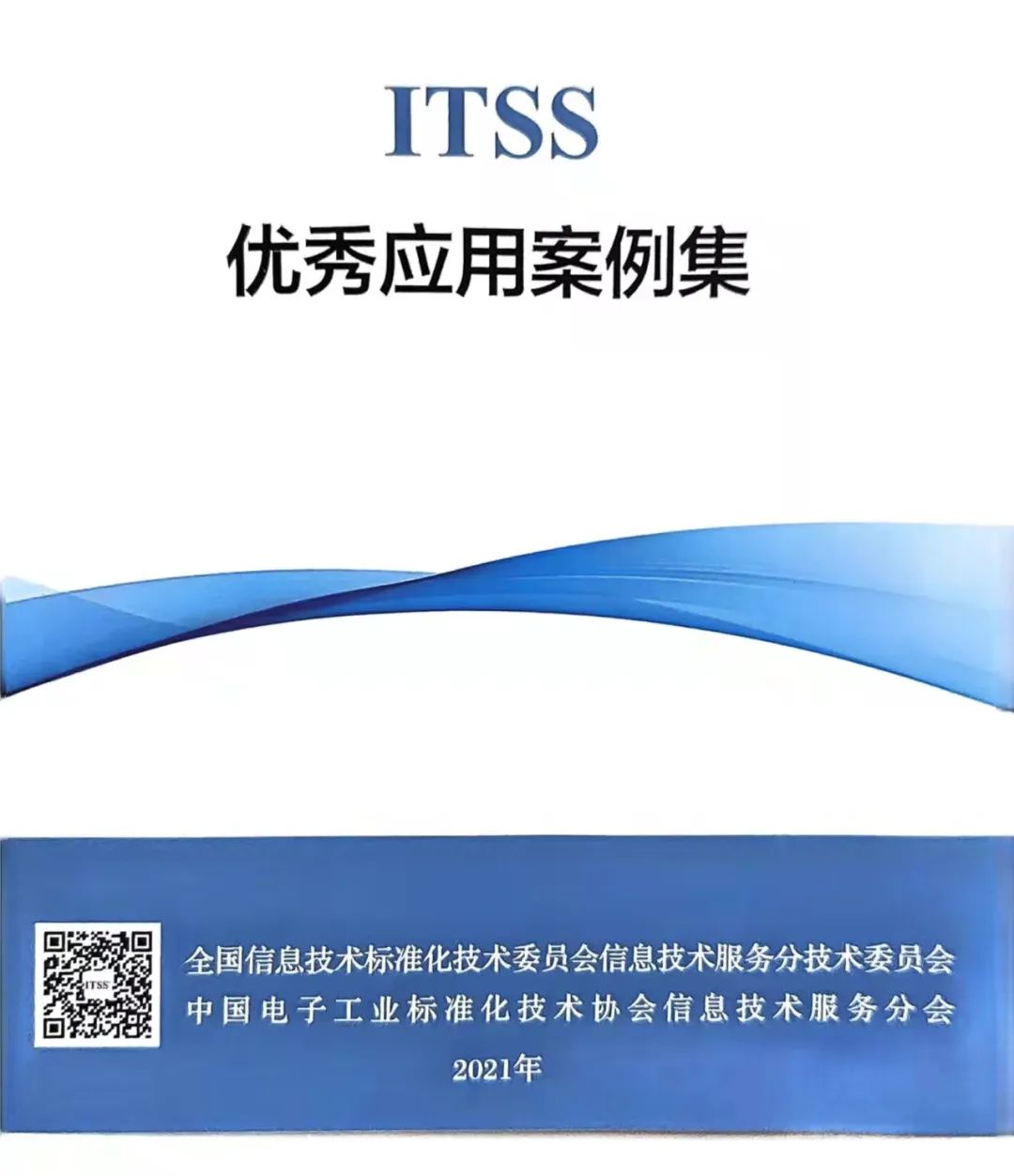
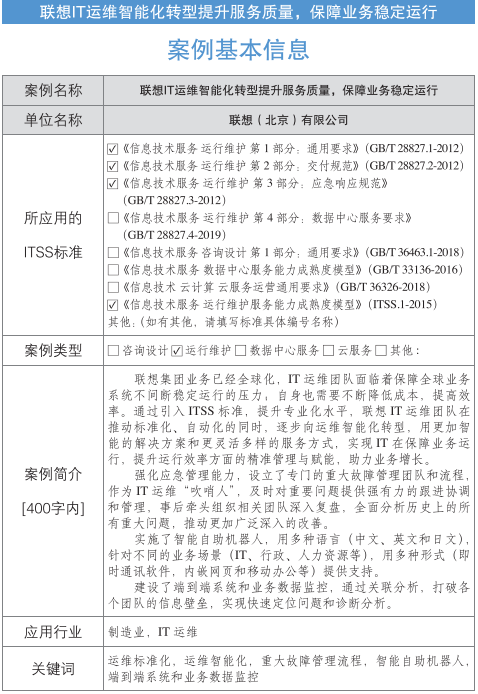
Case Background
1
Implementation Background
Lenovo Group is a Fortune 500 company founded in China, with operations in 180 markets. As a leading manufacturer of smart devices, Lenovo ranks 15th on Gartner’s top global supply chain list. Every year, Lenovo provides billions of smart terminal devices to users worldwide, including computers, tablets, and smartphones.
Lenovo has a large global workforce spread across 170 countries and regions, spanning all time zones. More than 70,000 documents are shared daily, with over 600,000 emails sent, and more than 160,000 one-on-one or multi-party online meetings held. All of this support is managed by Lenovo’s IT operations team, which also maintains over 25,000 IT devices, more than 4,500 physical servers, and over 400 business application systems.
The Lenovo IT operations team faces two challenges: on one hand, the business has globalized, and the complexity of business application systems is high, with a strong dependence on IT that cannot be interrupted. How can they provide 24/7 support for global operations while ensuring system stability? On the other hand, the IT operations team itself is also under pressure to continuously reduce costs, improve efficiency, and demonstrate professionalism and value. By introducing ITSS standards, they continuously promote the collaborative improvement of personnel, processes, resources, and technology, enhancing operational maturity and achieving precise management and empowerment of IT to support business operations and improve operational efficiency, thus facilitating business growth.
2
Implementation Goals
With Lenovo’s globalization, the development of IT operations has been divided into three stages, currently in the “Intelligent” stage.
The “Integration” stage (1998-2004): With the establishment of Lenovo, an information system was gradually built, especially the ERP system. During this stage, Lenovo’s operations were closely tied to hardware such as desktops, servers, and networks, establishing a unified IT service management system.
The “Globalization” stage (2005-2016): Starting from Lenovo’s acquisition of IBM’s ThinkPad business in 2005, the IT operations team focused on building a standardized operations service system. During this period, ITSS standards were introduced to continuously promote collaborative improvements in personnel, processes, resources, and technology, defining standard IT operations processes and service catalogs around core business systems, achieving significant technological advancements such as cloudification of infrastructure resources.
The Intelligent Operations stage (2017-present): In 2017, the Lenovo IT operations team proposed a strategy for the transformation of intelligent operations, implementing quantifiable management of operational service capabilities, ensuring business operation with smarter solutions and more flexible service methods. In the second half of 2019, they introduced level one maturity of ITSS standards, and by 2020, results were seen through the establishment and application of models that integrated models with service business, continuously improving and innovating operational work, developing applications independently to support both agile and stable business development. A quantitative evaluation system was established for capability management, delivery management, emergency management, personnel management, resource management, and technical management, promoting the research and development of operational technology to support corporate strategy, achieving the development of multi-cloud architecture and self-service.
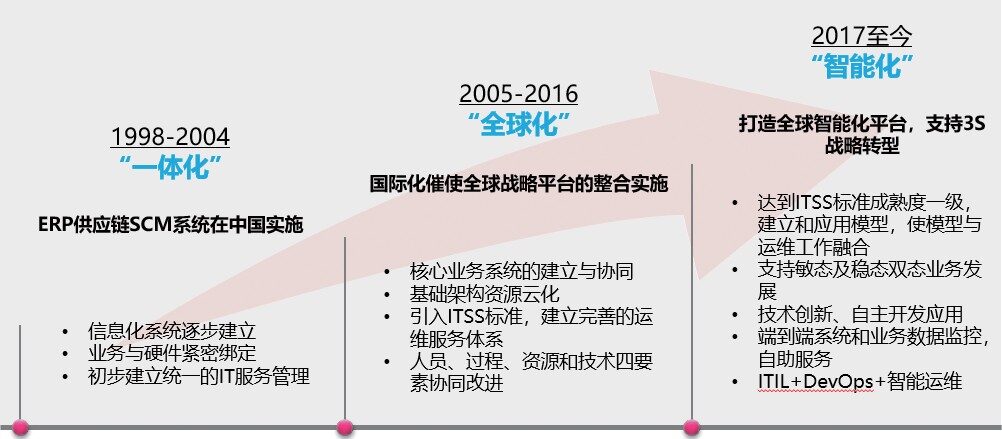
Application Process
1
Annual Work Summary Implementation Plan
Based on its own development needs, the Lenovo IT operations team proposed a strategy for intelligent operations transformation in 2017. By introducing ITSS standards, they developed and innovated a series of intelligent products and solutions that are not only applied in the IT field but also promoted to business teams, aiding in achieving digital operations.
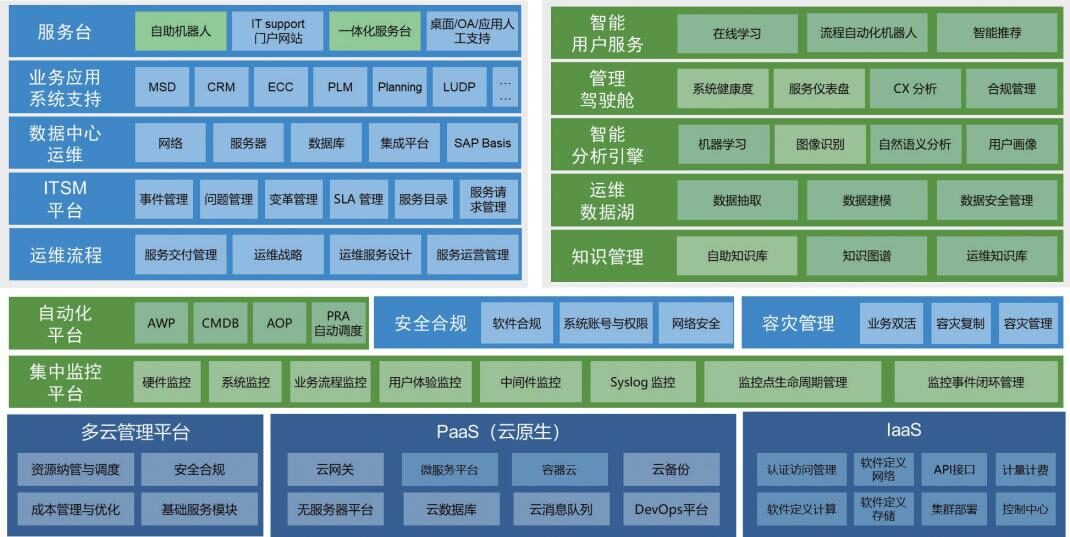
Figure 2
2
Implementation Process
Guided by ITSS standards, the Lenovo IT operations team promotes intelligent transformation around the four elements of personnel, resources, processes, and technology.
In terms of personnel, the Lenovo IT operations team, based on ITSS standards, has established unified processes for incidents, monitoring, problems, configuration, changes, and releases, clarifying responsibilities. For major incident management, they strengthened emergency management capabilities by establishing a dedicated MIM (Major Incident Management) team and processes to tackle critical issues, acting as the “whistleblower” for IT operations to provide strong follow-up coordination and management of important issues promptly and serve as a communication window for significant IT problems, providing real-time updates on processes. Afterward, they lead relevant teams in a thorough review to develop improvement measures to prevent similar issues from occurring again, promoting continuous optimization between IT and business teams. They comprehensively analyzed all major issues in history, proposed and promoted broader and deeper improvement measures, reinforced the sense of responsibility within the IT operations team, enhanced team combat effectiveness, demonstrated the value and capability of IT operations to the business team, and laid the organizational foundation for intelligent operations.
In terms of resources, in addition to implementing a CMDB to store hardware and software data of the IT environment, the operations team also implemented a data lake for operational data, integrating metrics, logs, incident, change, and other operational data, as well as IT environment data from the CMDB, ensuring high data quality to support IT user profiles, intelligent knowledge recommendations, and intelligent analysis applications.
In terms of processes, based on intelligent operations, they achieved real-time management dashboards for incidents, monitoring, problems, configurations, changes, and releases; implemented monitoring of SLA compliance; and realized a 360-degree system health check for core applications, allowing for real-time monitoring of application health, early warnings, and proactive fault responses; they also conducted customer experience analysis, solving issues based on a comprehensive understanding of user feedback, winning praise from users, especially key users in business departments.
Several intelligent initiatives were launched in the technical aspect; here are two examples:
Intelligent Self-Service Robot
As Lenovo’s workforce grew more than twofold over five years, the number of employee requests increased from 250,000 to 500,000. Such massive growth posed significant challenges for the operations team.
As the pressure on the operations service desk increased, we guided by the “Information Technology Service Operation and Maintenance Part 1: General Requirements” (GB/T 28827.1-2012), comprehensively enhanced engineer capabilities, optimized ticket management processes, strengthened service quality management, and consolidated standard IT service knowledge. On this basis, the operations team developed an intelligent self-service robot product that accurately understands user intentions through a natural language processing engine, combined with a knowledge graph to recommend a unique answer to users, achieving “easy to find”; then integrated the intelligent self-service with multiple business systems, allowing users to complete queries, applications, approvals, modifications, and other services with a single click through an optimized interface and simplified forms, achieving “easy to operate”.
After receiving unanimous recognition and praise from users, we maintained an open mindset and applied this technology to more internal enterprise service scenarios, providing diversified support in multiple languages (Chinese, English, and Japanese) for different business scenarios (IT, administration, human resources, etc.):
Instant messaging software: Skype is an essential instant messaging tool for every Lenovo employee daily. The robot service was deployed in the Skype account, allowing employees to access self-service in the most familiar way.
Embedded webpage: The embedded robot can be deployed on any webpage and can customize independent Q&A content. When users encounter issues on a web-based system, the robot answers questions on the page, informing users of solutions.
Mobile office: At Lenovo, the mobile office software “Le Liao” provides employees with a handy toolbox for chatting, leave requests, approvals, inquiries, and more. We developed a mobile robot for the Le Liao app, allowing employees to ask questions and get answers just like on the PC.
By implementing the intelligent self-service robot, the user net promoter score (NPS) increased from 50 to 72, with the annual response volume exceeding 300,000, saving approximately 25% of preparation time for IT service desk agents.
End-to-End System and Business Data Monitoring
As Lenovo’s business expanded, operations faced tremendous challenges, with a significant increase in hardware and software quantities and growing application complexity. Due to the long business chain at Lenovo, a fault often involves multiple systems, and the IT operations team could no longer monitor and handle faults with traditional tools, processes, and skills. Therefore, the operations team built end-to-end system and business data monitoring capabilities, breaking down information barriers across teams through correlation analysis, enabling rapid problem location and diagnostic analysis.
End-to-end system and business data monitoring must cover three layers: infrastructure, application systems, and business. The technical team drives monitoring metrics at the infrastructure layer, making them more generic and standardized; application-level monitoring is more customized based on different business needs and technical architectures; business-level monitoring is typically driven by business processes or scenarios, highly customized and often cross-application, ensuring stable execution of application systems and business through 24/7 real-time monitoring without blind spots.
By achieving end-to-end system and business data monitoring, we utilized big data technology, machine learning algorithms, and other means to complete intelligent early warnings for business processes. For example, in monitoring the Lenovo global supply chain planning system, which supports global supply chain operations, the business heavily relies on the planning system to output plans on time; failures can lead to inability to deliver, with serious consequences. More than 800 workflows span multiple modules of the planning system, integrating with upstream and downstream partner systems and the company’s internal ERP and MES systems, crossing multiple applications and technology stacks. The system solutions are broad in scope and high in complexity.
For this system, we monitored over 60,000 workflow nodes and around 100 application instances, collecting scattered system logs. Using big data and machine learning technologies, we employed dynamic alarm values, alarm compression, and correlation analysis to achieve intelligent early warnings for the global supply chain planning system, avoiding over 15% of planning delays.
Application Effects
Initially, the introduction of “Information Technology Service Operation and Maintenance Part 1: General Requirements” (GB/T 28827.1-2012) in 2013 led to significant improvements in the standardization of the Lenovo operations team. Subsequently, with strengthened business capabilities, they achieved level two maturity in ITSS operations in 2014. In 2019, the introduction of level one maturity standards for ITSS operations, through the establishment and application of models that integrated with IT operations business and continuous improvement, significantly enhanced operational service capabilities:
In terms of capability management, a historical data analysis model for Lenovo IT operations services was established, accumulating nearly five years of data to support business decision-makers;
In terms of delivery management, further optimizations were made to the original operational service delivery model, effectively controlling operational delivery costs, risks, returns on investment, and continuous improvement, introducing automation tools to track the operational service delivery process;
In terms of emergency management, capabilities were further strengthened by establishing dedicated major incident management teams and processes as the “whistleblower” of IT operations, creating a risk assessment mechanism for important information systems and reinforcing daily monitoring;
The operational service quality evaluation system was further refined, with tailored guidelines developed for project-level indicators;
In terms of personnel management, a quantitative evaluation system for operational personnel skills was established, achieving refined management of operational personnel by classification and grading;
In terms of resource management, monitoring tools and process management tools were established to realize data and information sharing and exchange standards, supporting statistical analysis, reporting, and quantitative management of operational service business;
In terms of technical management, analysis models were established around monitoring tools, manual inspections, and issue occurrence risks, selecting appropriate strategies based on input-output and business impact analysis;
In terms of process management, not only were processes recorded, but automation was also achieved wherever possible, such as recording, displaying, and integrating incident management with service quality evaluation indicators for statistical analysis.
With the introduction of level one maturity standards for ITSS operations in 2019, Lenovo’s operational management level progressed from “good” to “excellent,” yielding fruitful results in 2020:
In terms of service delivery, through improvements in capability management, delivery management, resource management, and process management, while ensuring 24/7 global service, the self-service rate increased from 30% to 50%, and the first-line resolution rate improved from 75% to over 80%, with SLA compliance rates rising from around 95% to over 98%.
In terms of application availability, comparing before and after the introduction, through enhancements in emergency management and technical management, availability improved from 99.5% to over 99.8%, with the ratio of P1 and P2 (highest and second-highest priority faults) decreasing from about 3% to less than 1%; for financial month-end support, the number of P1 and P2 incidents dropped from about 4 per month to below 1.
In terms of customer satisfaction, after refining the operational service quality evaluation system and personnel management, satisfaction rose from around 95% to over 98% in 2020.
As shown in the figure below:
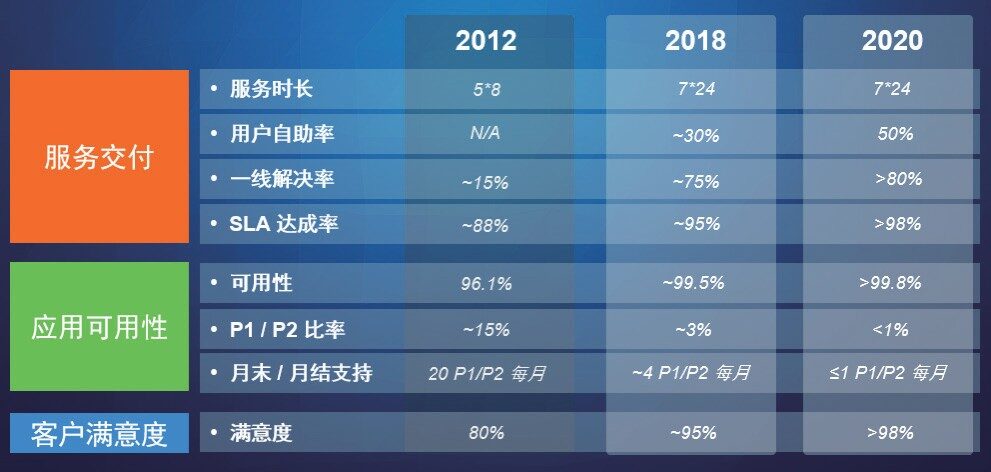
Figure 3
Adjustments and Suggestions
As a global enterprise, the Lenovo IT operations team continuously enhances standardization, automation, and intelligence to better ensure business operations. In the process of IT operations, they introduced ITSS standards, where service standardization is the cornerstone of the IT operations team’s service level improvement. For instance, after undergoing standardization, the IT service desk’s manual ticket data became complete, clearly categorized, and well-documented. After extensive analysis of numerous tickets, they found that issues with office software consistently ranked first, which became the first entry point for the intelligent self-service robot. On the other hand, service standardization also allows for consistent measurement of each team’s services, aligning service levels and improving user satisfaction.
Today, digitalization is breaking the boundaries of traditional IT operations, and standardization has made automation and intelligence possible. By transforming standardized processes into automated or even intelligent processes, they can better and faster serve users, primarily discovering and resolving faults, allowing business departments to focus on developing their own businesses while the IT operations team creates more value for the company.
WeChat Official Account|China-ITSS
Official Website|www.itss.cn
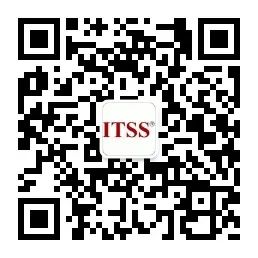
Information Technology Service Standards
Information Technology Service Standards